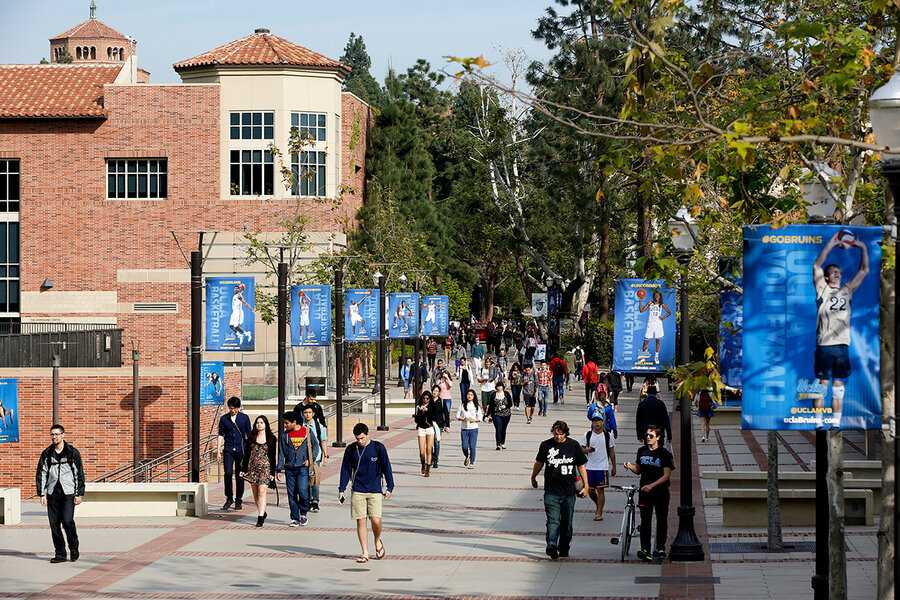Revolutionary thinking? Colleges let students opt out of admissions exams.
Loading...
| Chicago
Few things loom over American high school students more than college admissions tests. But a movement is accelerating across the United States, with more colleges giving students the choice of either submitting their SAT or ACT scores or not. Public and private colleges from Arizona to Illinois to Massachusetts – including some of the most elite – have adopted a test-optional model or are moving in that direction. It marks one of the biggest changes in college admissions in the past two decades.
Though the demise of the ubiquitous tests is far from inevitable, the shift in approach is contributing to a profound change in the way schools and society measure a person’s value. Instead of giving the impression that admissions is based largely on a single test score, more colleges now proclaim loudly that the totality of an individual is so important that a test score is no longer necessary. The result is a feeling of relief from students, but also more economically and racially diverse freshman classes.
“Testing has never been the most important part of our application process,” says Marjorie Betley, an admissions officer at the test-optional University of Chicago. “What better way to stress that than to just take [the requirement] away.”
Why We Wrote This
By moving away from test requirements, colleges are contributing to a profound change in the way society measures merit. Instead of a single SAT or ACT result, they’re reinforcing the importance of a student’s talents and character.
After classes and 4-H Club meetings and homework, Esmeralda Hernandez spent a portion of her spring semester junior year engaged in a nightly routine familiar to millions of American teens: logging on to a website to practice math, reading, and timed test-taking for the SAT.
While she scored fairly well, she decided to study more over the summer and take the entrance exam a second time. Her hard work paid off: She earned the highest score in her small senior class in tiny Swainsboro, Georgia. But for a farmworker’s daughter whose college aspirations stretched beyond state lines, it still didn’t seem good enough.
In her home nestled in the woods on a dirt road, she kept looking longingly at a postcard sent by the University of Chicago, her top choice. What always caught her eye was the image of a coffee stain on the card, which, when looked at closely, showed the chemical formula for coffee. The quirky intellectualism behind the card only reinforced her desire to attend the elite university.
Why We Wrote This
By moving away from test requirements, colleges are contributing to a profound change in the way society measures merit. Instead of a single SAT or ACT result, they’re reinforcing the importance of a student’s talents and character.
Yet she nearly gave up on her dream school, until she discovered it offered full scholarships – and the option of applying without submitting an SAT score. Suddenly, hope rushed back in, tinged with uncertainty.
“I thought that if I hid my test scores from the school, they would ask, what are you hiding?” she says. “But it was also very freeing in the fact that I didn’t have to be defined by something that was only four hours and didn’t really, in my opinion, define who I was as a person. ... There were so many more things that reflected how intelligent or motivated I was.”
Few things in life loom over American high school students more than college admissions tests. After years of toiling to earn good grades, years of slogging through Advanced Placement courses, and years of participating in extracurricular activities to burnish their credentials, many students take a test that they’ve been told can either catapult or crush their college hopes.
But now a movement is accelerating across the country – with more colleges giving students the choice of either submitting their SAT or ACT scores or not. Public and private colleges from Arizona to Illinois to Massachusetts – including some of the most elite – have adopted a test-optional model or are moving toward it. It marks one of the biggest changes in college admissions in the past two decades.
The result is a feeling of relief – and liberation – among both high schoolers and parents, in competitive metropolises and quiet rural towns alike. Perhaps more important, the move is contributing to a profound shift in the way schools and society measure a person’s value. Instead of giving the impression that admissions is based largely on a single test score, more colleges now proclaim loudly that the totality of an individual – yes, the good grades earned, but also the person’s unique talents and character – is so important that a test score is no longer necessary.
Rise of the “nonsubmitters”
Test-optional institutions continue to accept scores from students who want to share them, as one marker of achievement, and an average of 75% of their applicants still do. But the schools are breaking down some long-held notions about how to take stock of a student’s merit and likelihood of success – largely in the name of equity.
“What we do know about higher education is that it reproduces inequality ... and it’s good to try and destabilize that a little,” says Elisabeth Clemens, a sociology professor at UChicago who was not involved in creating the new test-optional policy.
This neo-Gothic campus, the Midwest’s closest equivalent to an Ivy League school, caused a buzz in the summer of 2018 as the first top-ranked university to go test-optional.
The list of bachelor’s degree-granting institutions that de-emphasize the tests has grown to 1,060 since Bowdoin College in Brunswick, Maine, pioneered test-optional in 1969. Today, more than half of the “top 100” liberal arts colleges are on the list, the National Center for Fair & Open Testing (FairTest) reports, and about 50 joined in the past year.
The first student class to include “nonsubmitters” of test scores arrived at UChicago this fall. Professor Clemens says she can’t tell who they are when she asks a class of first-year students to “wrestle with important arguments” in centuries-old texts like Hobbes’ “Leviathan.” She trusts that both types of applicants will thrive here, though she’ll keep an eye on research in the coming years on student performance.
The massive University of California system might be the next to go test-optional. Its Board of Regents had been considering dropping the SAT/ACT requirement even before students and a school district filed a recent lawsuit, claiming that the tests have a discriminatory effect because of racial and economic disparities.
California could prove a “tipping point, because it is the largest recipient of SAT scores in the country [and] it is viewed as the most prestigious public university system,” says Robert Schaeffer, FairTest’s public education director.
Yet the ubiquity of the tests suggests that their demise is far from inevitable. More than 2.2 million students in the high school class of 2019 took the SAT, and 1.8 million took the ACT. Many states require and pay for students to take one of the exams.
The nonprofit groups that own the tests push back vigorously against perceptions that they are unfair or put too much pressure on teenagers. Research has shown that when combined with high school GPA, the scores boost colleges’ ability to predict GPA and the likelihood that first-year students will return for a second year. “It’s a measuring tool. ... You cannot blame the measurement for inequities or inequalities in society,” says Marten Roorda, CEO of ACT, based in Iowa. Test makers use rigorous methods to ensure the test questions themselves are not biased, he says.
The SAT or ACT can provide opportunities for students, like Ms. Hernandez, whose talent otherwise might never have been discovered. Many colleges send out recruitment mailings to students with good scores who live in places their admissions officers don’t visit.
Advocates for the tests also say that high school GPAs are not comparable, because of highly localized school systems in the United States. Without a standardized benchmark like a test result, grade inflation could become a bigger problem, and “wealthier students [could] game the system by having stronger letters of recommendation” or other advantages, says Lynn Letukas, who formerly worked for the College Board (which owns the SAT) and co-edited the 2018 book “Measuring Success: Testing, Grades, and the Future of College Admissions.”
Hard work’s reward
This storied Harry Potter-esque UChicago campus fringed with modern architecture is a whole new world for Ms. Hernandez. Ninety-two Nobel laureates have walked the same stone stairways and underground tunnels she scurries through between classrooms and libraries.
Just as exciting to someone who used to have to drive for miles to get to Walmart, she can hop on her used olive-green bicycle and zip to class or a variety of stores in the Hyde Park community in a few minutes.
But the bike isn’t the only thing accelerating her. Attending UChicago is pushing her quickly up the social mobility ladder.
At one point, she thought all she could afford was to enroll in a state public university, where she could apply two years’ worth of credit she earned at community college during her high school years.
Her Mexican-immigrant parents didn’t attend college. And her only recent role model who left Swainsboro for an elite university was a family friend from church who went to Yale. But she felt encouraged by her small town – even the woman on the other side of the window where she went to pay her phone bill last summer asked about her plans.
Eyeing a major in political science and/or sociology, she says she’s grateful “to meet a lot more interesting people who all worked hard throughout their four years to get to someplace like this.”
She’s sitting at a dark wooden table in Hutchinson Commons, an Oxford-inspired dining hall and student lounge, where the global mix of students contrasts with stately rows of UChicago presidential portraits lining the walls. But even indoors, the Peach State native is still wearing her beige knit cap to ward off the cold.
Here she anticipates gaining insights from stellar professors, internships, and possibly a study-abroad trip to Paris or Barcelona. At a four-year school, she says, she can “be a young adult for a while, rather than just getting two years of university experience and then jumping out into a career field.”
UChicago requires applicants to write two essays, one about why they want to attend the school, and one based on their choice of five topics. “Can you read and write and think? That’s going to be a big indicator of how you do here,” says admissions officer Marjorie Betley.
Test-optional swayed Ms. Hernandez to apply, but her ability to come also depended on a broader set of policies – including financial aid – to open up access for underrepresented students. In the first round of test-optional admissions, in the fall of 2019, UChicago’s applications jumped 20% overall. But they went up 60% for rural students and 24% for first-generation students.
In rural communities, “there’s not a lot of test prep around there ... and a lot of students are driving two, three, four hours” to get to an SAT or ACT test, says Ms. Betley, director of the university’s Emerging Rural Leaders Program. “Testing has never been the most important part of our application process. ... What better way to stress that than to just take [the requirement] away.”
Ms. Hernandez’s former school, Swainsboro High School, recently hosted a test-taking session for the ACT. Among the school’s 160 seniors, just over half typically go on to college – usually within Georgia, says counselor Monica Pace.
Those applying for public universities or scholarships have to reach a minimum SAT/ACT score, and that can motivate students to work harder on math and reading, she says. One student aimed for a scholarship that requires a 1200 on the SAT. “This recent test, she was so excited,” says Ms. Pace.
“I think she’s taken it three times; she finally got her score.”
Burden or achievement?
For parents like Pat Lynch, any move away from the pervasive presence of the SAT or ACT in high schoolers’ lives is welcome. Just before noon on a crisp October Saturday, Ms. Lynch is browsing a catalog in the driver’s seat of her black Volvo, waiting for her daughter to emerge from the SAT at Nashua High School North in New Hampshire. Her daughter has already taken the SAT twice at her own Roman Catholic school, and the ACT once.
“She’s having a hard time getting a decent score, and she’s a smart kid – all A’s, great GPA, four years of math, four years of science – but these tests are a lot of pressure,” Ms. Lynch says.
She thinks her daughter will apply without scores to the three out of five colleges on her list that are test-optional. Colleges are “finding out that this SAT is a racket,” she says.
Not true, say the test makers. Since a new version rolled out in 2016, the SAT has dropped “all vestiges of the aptitude approach used to develop the early SAT 100 years ago,” College Board spokesman Zachary Goldberg writes in an email. “Gone are the infamous ‘SAT words,’ penalties for guessing, and math that isn’t necessary for college work.”
Ms. Hernandez acknowledges that her hours spent prepping on Khan Academy, an education platform that partners with the College Board to help applicants get ready to take the exam with a free online program, did some good. “I learned certain techniques in algebra ... [and] I got a lot of critical reading training. ... I can read extremely fast and still take a lot of things in.”
But the tests still feel like an unnecessary requirement to many students.
“Being good at standardized testing is being good at standardized testing,” says a UChicago first-year student from California who asked to keep her name private.
Freshman Daniel Gendy says he felt a lot of pressure to compare his test scores with those of other potential applicants on college online forums. The night before he sent in his UChicago application, he decided to check the test-optional box. “I was involved with my high school’s founding of a robotics team, and I wanted that or other extracurriculars, such as fencing, to represent me,” he says.
Some students think too much focus on testing can be a detriment to the academic culture.
“Schools are supposed to be about learning and education and just expanding your mind as much as possible,” says fourth-year UChicago economics and philosophy major Max Marcussen, who hails from a rich Connecticut town where testing and tutoring go hand in hand. With test-optional admissions, the hope is that “having less emphasis on test scores means that you can focus more here on what actually matters.”
Several weeks into her first quarter, Ms. Hernandez dropped her calculus class. She had tested into it, and plans to take it later, but she found that having the optional fourth class in her schedule left no time for extracurriculars. Now she’s enjoying the Model United Nations club and tutoring adults for the citizenship test.
Students here say the curriculum challenges everyone, and they get tremendous support from professors and peer tutors. But researchers have been curious about whether the academic outcomes at test-optional schools are different for those who don’t submit exam scores. A 2018 study of 28 large and small institutions found that nonsubmitters had marginally lower first-year and cumulative college GPAs than submitters. But nonsubmitters graduated at equivalent or slightly higher rates. The report, co-authored by a test-optional supporter, showed that first-generation, low-income, female, and underrepresented minority students were more strongly represented among those who didn’t submit test scores.
Supporters of testing say the growth of diversity on these campuses can’t necessarily be linked to test-optional policies, because the schools often offer other incentives to students, including financial ones. To help schools with their diversity goals, the College Board recently added a feature called Landscape, which helps give a fuller portrait of who students are and where they come from by putting scores in the context of neighborhood and school demographic information.
SAT and ACT scores “can be a valuable indicator for certain students,” says Peter Wilson, UChicago’s director of undergraduate admissions. “If the students feel like it shows their intelligence or it shows how they’re doing, we would love them to send it in. I don’t think we would ever get rid of it or say we’re going to be test-blind.”
Yet that’s exactly what testing critics in California want at public universities.
A growing revolt
Use of the SAT and ACT is “morally impermissible ... and the admissions process should no longer be contaminated by this discriminatory metric,” said Mark Rosenbaum, directing attorney at the nonprofit Public Counsel, in filing a lawsuit Dec. 10 against the University of California system on behalf of students and the Compton Unified School District.
California data from 2019 show that 45% of white students scored 1200 or above on the SAT, compared with 9% of African American students and 12% of Hispanics. The University of California’s Academic Senate had already begun considering removal of the test requirement and is expected to make recommendations within a few months.
The growing revolt over testing could bolster a backlash against another pillar of the higher education establishment – testing-based merit aid. Some colleges, such as Worcester Polytechnic Institute (WPI) in Massachusetts, have already stopped considering test scores when handing out discretionary scholarships.
Breaking down the connection between “so-called merit scholarships” and SAT/ACT scores is “the next frontier to broaden accessibility to higher education,” says FairTest’s Mr. Schaeffer.
Admissions shifted to test-optional at WPI in 2007. Since then, the school has not only seen diversity rise, but also retention and graduation rates. But with costs as much a barrier to entry as the admissions tests, leaders decided that tying aid to the exams could hamper their goal to broaden access to science and technology degrees.
First, they stopped participating in the National Merit Scholarship Program, which requires the PSAT in junior year. But WPI’s algorithm for its own merit scholarships still used SAT/ACT scores. So in the 2016-17 cycle, the school started assigning an average test score to applicants who hadn’t submitted exam results. The next year, they cut standardized test scores completely out of the merit aid calculation.
“The public narrative that testing firms often play into is this idea that test scores are a proxy for academic quality,” says Andrew Palumbo, WPI’s dean of admissions and financial aid. Once a critical mass of schools goes test-optional – particularly more nationally known universities – he believes that notion will fade. “The biggest problem we have now is the legacy of standardized test scores – the myth that they are the great equalizer upon which you can put everyone side by side,” he says.
Yet some schools have gone in the opposite direction. In 2013, the University of Oregon added test scores to its merit scholarship requirements, while still considering high school GPA. The method was more transparent and the school boosted its academic profile, reports “Measuring Success.”
Hezekiah Owuor, for one, is happy with the approach WPI took. The student at the technical institute built a computer and taught himself to play piano, guitar, ukulele, and drums back in his hometown of Mombasa, Kenya. Now he’s the beneficiary not only of test-optional admissions, but of test-neutral merit aid as well.
“I never had the resources and facilities to be able to just simply explore,” he says of his interest in combining music and computer science. Halfway through his second year at WPI, he’s planning an independent study “to write code that reacts to sound and music.”
Mr. Owuor sat for the SAT and the ACT in Kenya, putting in several hours of studying online each week for about a month. On top of exams for his International Baccalaureate degree, he didn’t have enough prep time to score as high as he had hoped, he says. When his counselor told him about WPI, he decided to apply without submitting his scores. He believes the school’s test-optional philosophy has not only been beneficial to him but has also had a positive effect on campus culture.
“You don’t feel like you are defined by the number that you got,” he says. “It’s very much an environment of innovation and what you can bring to the table – what you can do, as opposed to what this test said that you could do.”












